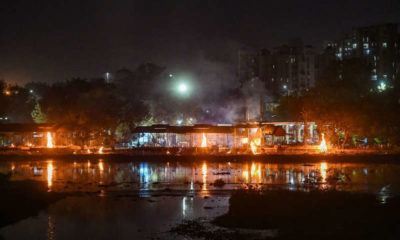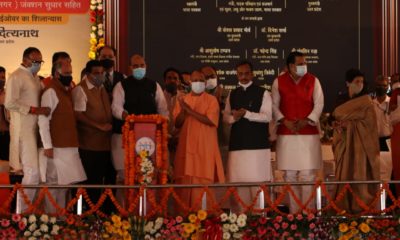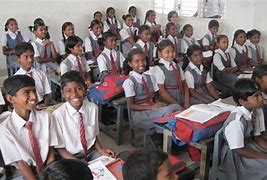Feature
ETCs help check case fatality in AES patients

Lucknow, 14th December: To address high case fatality due to Acute Encephalitis Syndrome (AES), in 2013- 2014, the Government of Uttar Pradesh established Encephalitis Treatment Centers (ETCs). This has led to a significant reduction in the number of AES cases from 3,018 cases in 2014 to 2,711 cases (until November 2015). The case fatality rate has also declined from 18.53 in 2014 to 15.53 in 2015.
With support from PATH, an expert committee group had recommended policy guidelines on the clinical management of AES and the setting up ETCs. The ETC model works on the basis that if suspected AES cases are oxygenated and treated within 30 minutes of the onset of fever in the nearest health facility, permanent brain damage and death can be prevented. As of date, 104 ETCs have been established in the primary and secondary health care centers across seven districts of Gorakhpur and Basti division.
 The health facilities were upgraded with adequate infrastructure and trained manpower. Eight Intensive Care Units (ICUs) equipped with ventilators were supplemented with trained government health personnel available round the clock. Linkages were established with the existing free ambulance services to transport suspected AES patients to the ETCs within the minimum time possible.
The health facilities were upgraded with adequate infrastructure and trained manpower. Eight Intensive Care Units (ICUs) equipped with ventilators were supplemented with trained government health personnel available round the clock. Linkages were established with the existing free ambulance services to transport suspected AES patients to the ETCs within the minimum time possible.
Presenting an overview of AES and Japanese Encephalitis (JE) in Uttar Pradesh for the media in Lucknow, the Principal Secretary, Health, Mr. Arvind Kumar, IAS, said that AES and JE continued to be a major public health challenge not only in India but in other parts of Asia too. He said approximately 375 million people were at risk of developing AES in India, with an incidence rate of 0.46 per 100,000 population.
AES continues to be one of the most difficult syndromes due to its high morbidity and mortality rates. Japanese encephalitis is one of the leading viral causes of AES and evidence shows that it predominantly affects children below 15 years of age. Twenty four countries are endemic for JE and around the global, 67,900 cases of JE are reported annually. In the past few years, 24 districts of Gorakhpur, Basti, Devi Patan, Azamgarh, Faizabad and Lucknow division have been identified as JE endemic, which contribute to 90 percent of the AES and JE burden in Uttar Pradesh.
The Principal Secretary provided an overview on the Government of UP’s initiatives on AES and JE control. He said that in eastern Uttar Pradesh, with the onset of fever, most patients living in rural areas seek treatment from informal doctors or traditional healers. When the condition of the patient worsens family members rush them to distant hospitals or to the Baba Raghav Das (BRD) Medical College, Gorakhpur without seeking treatment at the nearby primary or secondary health care facilities. However, by the time the patient reaches the tertiary level of health facility, due to delay in treatment, irreversible brain damage sets in and around 30 – 40 percent cases develop disabilities and neurological disorders while around 30 percent cases die. At BRD Medical College, Gorakhpur, due to the large case load of AES and JE patients, a 100 bedded ICU facility is also available for pediatric patients.
Dr. Pradeep Haldar, Deputy Commissioner Immunization, Government of India said that in India there are 204 endemic districts in 21 states. Following a massive outbreak in 2005 in Uttar Pradesh and Bihar, the Government of India introduced the JE vaccination program in 2006, and till date about 11.5 crore children have been immunized. In 2015, JE vaccination campaigns were also conducted in three states – West Bengal, Assam and Uttar Pradesh due to the emergence in children above 15 and adults. In Uttar Pradesh, the adult campaigns were conducted in six districts of Gorakhpur and Basti Division where in 38 lakh beneficiaries were immunized. One hundred twenty one sentinel sites have been established across India to test for JE.
In 2015, Chief Minister, Akhilesh Yadav launched Information, Education and Communication (IEC) materials including an animation film to generate awareness within the communities on early recognition of danger signs, home based care, and preventive measures for AES/JE.
Mass awareness campaigns were also conducted and around 300 community meetings were conducted by PATH to generate awareness on prevention of AES/JE and to sensitize communities on the free services provided by the Government of UP for treatment of AES and JE. PATH supported the capacity building of over 30.000 medical officers, frontline workers and paramedics in 2014. In 2015, PATH also conducted a refresher’s training on AES and JE for over 12,000 medical officers, frontline workers and paramedics.
To evaluate the impact of the ETCs, a third party agency CORT conducted an assessment. The results showed that since the upgradation of health facilities, treatment at ETCs had increased and around 91 percent cases sought treatment at the district hospital. The average time for seeking treatment between the onset of symptom to hospitalization had also reduced to two days for those who availed services at ETCs.
Interim Country Program Leader, PATH India Evan Simpson said that PATH would continue to provide technical support to government of UP in the efforts to combat AES and JE. “The key areas of support will include strengthening ETCs, capacity building of health personnel, generation community awareness and strengthening the data management system,’ he added.
Integrated approaches taken by the Government of Uttar Pradesh
· Activities undertaken under the JE Program: Vaccination campaigns for children and adults and two doses of JE vaccine administered to children between nine months to two years of age.
· A Vector Borne Disease Surveillance Unit (VBDSU) and one JE sub-office was established at BRD Medical College, Gorakhpur, Uttar Pradesh. Physical, Medicine and Rehabilitation (PMR) department established at BRD Medical College, Gorakhpur for treating physical disabilities due to AES/JE.
· Community awareness
· Establishment of JE and AES wards to function as Encephalitis Treatment Centers.
· Integrated approach being used for addressing AES/JE. Interdepartmental coordination between Health, Water and Sanitation, Panchayati Raj Institutions, Public Health Engineering Department (PHED), National Commission for Protection of Child Rights, Education and Integrated Child Development Services (ICDS).
PATH is the leader in global health innovation. An international nonprofit organization, PATH saves lives and improves health, especially among women and children. PATH accelerates innovation across five platforms—vaccines, drugs, diagnostics, devices, and system and service innovations—that harness its entrepreneurial insight, scientific and public health expertise, and passion for health equity. By mobilizing partners around the world, PATH takes innovation to scale, working alongside countries primarily in Africa and Asia to tackle their greatest health needs. Together, PATH delivers measurable results that disrupt the cycle of poor health. For more information, visit: www.path.org.
Entertainment
Meghalaya Reserves Legalized Gambling and Sports Betting for Tourists

The State Scores Extra High on Gaming-Friendly Industry Index
Meghalaya scored 92.85 out of 100 possible points in a Gaming Industry Index and proved to be India’s most gaming-friendly state following its recent profound legislation changes over the field allowing land-based and online gaming, including games of chance, under a licensing regime.
The index by the UK India Business Council (UKIBC) uses a scale of 0 to 100 to measure the level of legalisation on gambling and betting achieved by a state based on the scores over a set of seven different games – lottery, horse racing, betting on sports, poker, rummy, casino and fantasy sports
Starting from February last year, Meghalaya became the third state in India’s northeast to legalise gambling and betting after Sikkim and Nagaland. After consultations with the UKIBC, the state proceeded with the adoption of the Meghalaya Regulation of Gaming Act, 2021 and the nullification of the Meghalaya Prevention of Gambling Act, 1970. Subsequently in December, the Meghalaya Regulation of Gaming Rules, 2021 were notified and came into force.
All for the Tourists
The move to legalise and license various forms of offline and online betting and gambling in Meghalaya is aimed at boosting tourism and creating jobs, and altogether raising taxation revenues for the northeastern state. At the same time, the opportunities to bet and gamble legally will be reserved only for tourists and visitors.
“We came out with a Gaming Act and subsequently framed the Regulation of Gaming Rules, 2021. The government will accordingly issue licenses to operate games of skill and chance, both online and offline,” said James P. K. Sangma, Meghalaya State Law and Taxation Minister speaking in the capital city of Shillong. “But the legalized gambling and gaming will only be for tourists and not residents of Meghalaya,” he continued.
To be allowed to play, tourists and people visiting the state for work or business purposes will have to prove their non-resident status by presenting appropriate documents, in a process similar to a bank KYC (Know Your Customer) procedure.
Meghalaya Reaches Out to a Vast Market
With 140 millions of people in India estimated to bet regularly on sports, and a total of 370 million desi bettors around prominent sporting events, as per data from one of the latest reports by Esse N Videri, Meghalaya is set to reach out and take a piece of a vast market.
Estimates on the financial value of India’s sports betting market, combined across all types of offline channels and online sports and cricket predictions and betting platforms, speak about amounts between $130 and $150 billion (roughly between ₹9.7 and ₹11.5 lakh crore).
Andhra Pradesh, Telangana and Delhi are shown to deliver the highest number of bettors and Meghalaya can count on substantial tourists flow from their betting circles. The sports betting communities of Karnataka, Maharashtra, Uttar Pradesh and Haryana are also not to be underestimated.
Among the sports, cricket is most popular, registering 68 percent of the total bet count analyzed by Esse N Videri. Football takes second position with 11 percent of the bets, followed by betting on FIFA at 7 percent and on eCricket at 5 percent. The last position in the Top 5 of popular sports for betting in India is taken by tennis with 3 percent of the bet count.
Local Citizens will Still have Their Teer Betting
Meghalaya residents will still be permitted to participate in teer betting over arrow-shooting results. Teer is a traditional method of gambling, somewhat similar to a lottery draw, and held under the rules of the Meghalaya Regulation of the Game of Arrow Shooting and the Sale of Teer Tickets Act, 2018.
Teer includes bettors wagering on the number of arrows that reach the target which is placed about 50 meters away from a team of 20 archers positioned in a semicircle.
The archers shoot volleys of arrows at the target for ten minutes, and players place their bets choosing a number between 0 and 99 trying to guess the last two digits of the number of arrows that successfully pierce the target.
If, for example, the number of hits is 256, anyone who has bet on 56 wins an amount eight times bigger than their wager.























